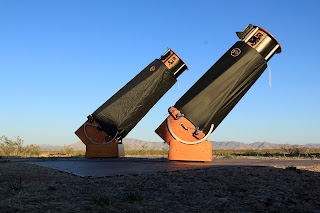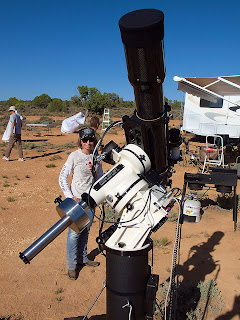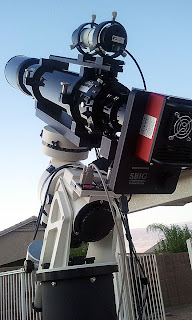| My wife Toni and I with the 15" Obsession awaiting sunset at the 2012 Grand Canyon North Rim Star Party |
Do you ever just stop and look at your life and think, "Dude!!! Life is good!!" I've been thinking that for awhile now. Life is good, probably better than I deserve it. My wife and daughters are awesome to be around and I supplement them with some great friends. Through this brutal economic downturn I've been fortunate enough to stay steadily employed and prospects for the future are looking good as well. I've had time to get back to the outdoors which I love; hiking and camping and traveling and just enjoying the world away from the busy city life. I get more time now than I used to for astronomy and I've been fortunate enough to put together a decent astrophotography rig over the last 18 months. I don't say all of this to boast, it's more of a reminder to myself to really enjoy the fortune that comes my way because it can all turn in a second and be gone. I'm grateful for everything that I've been given in this life and I treasure every moment of it.
Astronomy-wise, I've reached a point with my imaging rig that I'm really close now to what I'd call "perfect" for me. I've reached a point where it's time to take stock of what I have and where I'm at. I haven't written in this blog much in the last 6 or 8 months but it's not that I haven't been hard at work getting on in this life. Read back a little ways and you'll see that what's posted here is a grand departure from what I was rocking just a year ago. So here's what I'm at and where I think it's all going. This time around, I'll tackle the hardware. Next time, it'll be the software and peripheral equipment. And then hopefully, I can start sharing some of my own tips, tricks and thoughts about that equipment in upcoming installments. I do feel like my skills have developed enough that I can contribute at least a little bit of useful knowledge back to the imaging community. Check back in a year and we'll see if I'm right about all that.
Visual Astronomy
 |
| The 15" Obsession awaits the advanced darkness of Portal, Arizona's skies back in April. My friend Chris's 20" Obsession is in the background. |
Since I took up the dark art of deep sky imaging some 18 months ago I've always had this goal that I would build an imaging rig that would be semi-automated and I would be able to collect data and observe visually at the same time. Finally, my imaging rig is approaching that ideal and I've been able to get more time to observe with my own peepers. For 10 years now I have done my visual observing with my trusty 15" f/4.5 Obsession dobsonian. For me it's been the perfect balance of large aperture, small size and excellent optics. I doubt that I will ever part with it. As my wife once said, "It's the type of telescope that you don't sell - ever!". In the last 18 months, I've been fortunate enough to observe with some guys who are far better astronomers than I and I've learned bucketloads from them about seeing things in the night sky. I'm embarrassed to say that a telescope of this caliber has probably been wasted on my unpracticed eye for this long. One day, I'll write an entire column and give this telescope a proper review. After ten years I think I've had it long enough to give a full run down of it's capabilities and it's minimal shortcomings. Like any good astronomer, I check out those sexy new dobs with the super short focal ratios and ridiculous large aperture all the time. But the bottom line is that I'll never exhaust the capabilities of this scope in my lifetime.
The Mount - Astro-Physics AP900GTO
 |
| The AP900 waits for darkness at the May 2012 annular eclipse in southern Utah. |
I might have mentioned in another column once how I was pretty well set on my mount for awhile with my Hypertuned Celestron CGE. I was happy with that mount at the time - but alas, it's not an Astro-Physics mount. The opportunity to purchase an AP900GTO came along recently and I took advantage of it knowing that I'd likely keep the mount for the rest of my life. When I chose this mount I also considered the AP1200 and the respective Paramounts but in the end decided this was the best choice based on size, weight and availability. I haven't thus far been disappointed. My friend Bruce who is not an amateur astronomer called the mount "industrial art" when he first saw it.
I've only had it out a couple of times so far, but I couldn't be happier. It just works. With the electronics stored in the mount controller itself, I don't have to hook up the keypad to use the mount. I just attached the laptop to the serial connection and the excellent Astro-Physics driver controls all the interaction with the mount from either MaximDL or SkyTools. It can be controlled from any ASCOM compliant software but those are the two that I use. After I get a little more experience with it I'll give it a proper review. It's been a no fuss mount so far. When I look at my guide logs I see that the autoguider is only sending a correction to the mount about once every 45 to 60 seconds. So what erased any doubt about the quality of an AP mount for me? I'm glad you asked. Periodic Error tells the whole story. Check out the graphic below:
- Celestron CGE Uncorrected - 52 arc seconds peak to peak
- Celestron CGE w/PEC Enabled - 4 arc seconds peak to peak
- AP900 Uncorrected - 1.4 arc seconds peak to peak
 |
| At 1.45" peak to peak, the AP900 has less native periodic error than the seeing conditions in most people's skies. |
- Setting the mount to slew/guide past the meridian
- Daytime polar alignment procedure is a huge time saver when it gets dark.
- It has more weight capacity than I'll ever need in a field portable mount.
- 1.5 arc seconds of periodic error out of the box. I haven't even bothered to measure PE with PEC enabled. The seeing is never good enough to make a meaningful measurement. If I dare say it - the mount is seeing limited.
The Telescope - Explore Scientific ED127CF
 |
| Explore Scientific ED127CF refractor 127mm f/7.5 carbon fiber triplet |
I'll just say it. I don't love diffraction spikes in my images. If you look up "Diffraction Spike Admirer" in the dictionary you will not find my photograph next to it. I know some people dig them. I'm not one of them. It's one of the main reasons I even started looking for something beyond Hyperstar. The fast images were awesome and I still think it's the best way for a complete newbie to learn the imaging ropes - but those cables in front of the corrector plate created some nasty spikes in the images. I have an 80mm refractor at home that I've had for awhile and I was curious how it would perform so I put it on a mount and took some frames. I instantly fell in love with the spikeless stars and the much better color saturation and started shopping for a refractor. I chose the Explore Scientific ED127CF. So far, I'm really happy with the scope. I don't know if this is the "lifetime imaging" scope yet, but I do like it.
I'd love to talk about how great of a job it does on the planets and the crisp, contrasty, color-free views that it gives through the eyepiece but I can't. I've looked through the telescope exactly once. It has spent its entire life thus far as an imaging scope save for that first night out. I immediately replaced the focuser on the scope with a 2.5" Moonlite focuser with stepper motors. In conjunction with FocusMax I've been able to eliminate the chore of manual focusing from an imaging run. It takes about 30 seconds for the laptop to focus the telescope and it does a better job than even the trusty bahtinov mask. Look for a full review of the ED127CF and it's suitability as an astrophotography platform coming sometime in the future. My only complaint thus far is that there is a bit of blue fringing around brighter stars when I take long exposures through my QHY8PRO one shot color camera. A monochrome camera and filters would solve that problem though...
The Camera - SBIG ST-8300M
 |
| SBIG ST-8300M with FW8-8300 filter wheel. The QHY5 and 50mm finder/guidescope is also shown. |
Say hello to the newest addition to the imaging rig. I have made the transition to a mono camera and filters. This addition is still so new that I haven't even had a proper first light yet - hopefully this weekend. I recently bought an SBIG ST-8300m CCD camera and FW8-8300 filter wheel off of Astromart. The deal also came with a full complement of Astrodon LRGB and 3nm narrowband filters. A test run in early July showed that the focuser didn't really have enough out-travel to reach focus with this setup. I tried to cobble together a useable setup just to play around with it but the increased weight hanging off the end of the focuser created major flexure issues. I ordered a focuser extension from Moonlite and a threaded adapter so that I have the most solid possible connection from camera to telescope. Those parts are at home now but I haven't had a chance to assemble the rig and test it. I've done some calculations and I expect that I'll be able to eliminate the need for a field flattener with this camera. Experience will answer that for sure though.
I'm expecting big things from this camera and filter set. With a full set of narrowband filters and our typical long stretches of excellent weather in Arizona I should be able to greatly increase the amount of time I have for imaging since they'll allow me to image from my moonlit, light polluted backyard. The scope and camera combination provides me with an excellent image scale at 1.17"/pixel so I think this combination will be around for a long, long time.
What's Missing?
I do believe that I'm really, really close to my perfect imaging rig here. From a hardware standpoint I have the perfect mount. My only complaint about the imaging scope is the violet color around the brightest of stars in a long exposure. I expect that being able to focus each filter individually with my new mono camera will render that problem solved. The camera is a nice size chip that's a proven performer and it's shooting through the best filters possible. Much like my 15" Obsession, the imaging rig is setup in such a way that there's a lifetime of imaging there that I'll never be able to finish. The only thing left that I would like to address is a better guiding solution. I will probably add an off axis guider and a more sensitive guide camera some time in the near future. At that point, there's nothing that I think I could improve from a hardware standpoint.
I could possibly see an equipment rotator at some point in the future, but the system would have to demonstrate a real need for that piece of hardware. Most people add the rotator to help them find suitable guide stars. With the AP900 mount and a sensitive guide camera I should be able to take long enough guide exposures that I'll be able to find a guide star anywhere in the sky. So I don't see it becoming a necessity - but experience is the best teacher. I'll evaluate an equipment rotator once I've integrated the rest of this equipment.
Next time...I'll talk about the other half of the equation - software and the peripheral equipment. Now that the hardware piece is (all but) completed, I'll turn my attention to the software integration and automation. I'll share my thoughts and tips as I go. Until then....here's the last image shot with the QHY8PRO camera and the first dark sky image shot with the AP900 - NGC 5907. I shot this from the incredibly dark skies of southern Utah over the weekend of May 20th, 2012. Here's hoping the monsoon cooperates and I can feature a new image here next week.
| NGC 5907 - 7h 45m exposure (31 x 900s) |
This comment has been removed by the author.
ReplyDeleteExcellent hotel, service, food, room environment all are excellent. Friendly and cooperative staff. Pakistani escorts just execellent
ReplyDelete
ReplyDeletePakistani escorts can bolster your cerebrum, your body and Soul and give you remarkable satisfaction spurning you to cry with bliss. These Escorts are remedially attempted with the objective that you don't need to take at whatever reason for strain. Our Escorts also give a high class of Massage Service which removes up your body and your tiredness have gone. If you have to meet one of our Real Pakistani Escorts in Dubai and preferred standpoint however much as could sensibly be normal from your night with them, fundamentally.
ReplyDeleteThank you so much for posting this important information. This is great.
Hotel Management & Solutions
Revenue Management
I finally found great post here.I will get back here. I just added your blog to my bookmark sites. thanks.Quality posts is the crucial to invite the visitors to visit the web page, that's what this web page is providing. best roombas for hardwood floors
ReplyDeleteI really loved reading your blog. It was very well authored and easy to undertand. Unlike additional blogs I have read which are really not tht good. I also found your posts very interesting. In fact after reading. I had to go show it to my friend and he ejoyed it as well!
ReplyDeleteTreadmill 350 Lb Weight Capacity in 2019